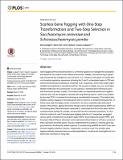| dc.contributor.author | Landgraf, Dirk | |
| dc.contributor.author | Huh, Dann | |
| dc.contributor.author | Hallacli, Erinc | |
| dc.contributor.author | Lindquist, Susan | |
| dc.date.accessioned | 2017-04-06T20:24:40Z | |
| dc.date.available | 2017-04-06T20:24:40Z | |
| dc.date.issued | 2016-10 | |
| dc.date.submitted | 2016-03 | |
| dc.identifier.issn | 1932-6203 | |
| dc.identifier.uri | http://hdl.handle.net/1721.1/107918 | |
| dc.description.abstract | Gene tagging with fluorescent proteins is commonly applied to investigate the localization and dynamics of proteins in their cellular environment. Ideally, a fluorescent tag is genetically inserted at the endogenous locus at the N- or C- terminus of the gene of interest without disrupting regulatory sequences including the 5’ and 3’ untranslated region (UTR) and without introducing any extraneous unwanted “scar” sequences, which may create unpredictable transcriptional or translational effects. We present a reliable, low-cost, and highly efficient method for the construction of such scarless C-terminal and N-terminal fusions with fluorescent proteins in yeast. The method relies on sequential positive and negative selection and uses an integration cassette with long flanking regions, which is assembled by two-step PCR, to increase the homologous recombination frequency. The method also enables scarless tagging of essential genes with no need for a complementing plasmid. To further ease high-throughput strain construction, we have computationally automated design of the primers, applied the primer design code to all open reading frames (ORFs) of the budding yeast Saccharomyces cerevisiae (S. cerevisiae) and the fission yeast Schizosaccharomyces pombe (S. pombe), and provide here the computed sequences. To illustrate the scarless N- and C-terminal gene tagging methods in S. cerevisiae, we tagged various genes including the E3 ubiquitin ligase RSP5, the proteasome subunit PRE1, and the eleven Rab GTPases with yeast codon-optimized mNeonGreen or mCherry; several of these represent essential genes. We also implemented the scarless C-terminal gene tagging method in the distantly related organism S. pombe using kanMX6 and HSV1tk as positive and negative selection markers, respectively, as well as ura4. The scarless gene tagging methods presented here are widely applicable to visualize and investigate the functional roles of proteins in living cells. | en_US |
| dc.description.sponsorship | United States. National Institutes of Health (NS087557) | en_US |
| dc.description.sponsorship | American Parkinson Disease Association, Inc. | en_US |
| dc.language.iso | en_US | |
| dc.publisher | Public Library of Science | en_US |
| dc.relation.isversionof | http://dx.doi.org/10.1371/journal.pone.0163950 | en_US |
| dc.rights | Creative Commons Attribution 4.0 International License | en_US |
| dc.rights.uri | http://creativecommons.org/licenses/by/4.0/ | en_US |
| dc.source | PLoS | en_US |
| dc.title | Scarless Gene Tagging with One-Step Transformation and Two-Step Selection in Saccharomyces cerevisiae and Schizosaccharomyces pombe | en_US |
| dc.type | Article | en_US |
| dc.identifier.citation | Landgraf, Dirk, Dann Huh, Erinc Hallacli, and Susan Lindquist. “Scarless Gene Tagging with One-Step Transformation and Two-Step Selection in Saccharomyces Cerevisiae and Schizosaccharomyces Pombe.” Edited by Arthur J. Lustig. PLOS ONE 11, no. 10 (October 13, 2016): e0163950. | en_US |
| dc.contributor.department | Massachusetts Institute of Technology. Department of Biology | en_US |
| dc.contributor.mitauthor | Lindquist, Susan | |
| dc.relation.journal | PLOS ONE | en_US |
| dc.eprint.version | Final published version | en_US |
| dc.type.uri | http://purl.org/eprint/type/JournalArticle | en_US |
| eprint.status | http://purl.org/eprint/status/PeerReviewed | en_US |
| dspace.orderedauthors | Landgraf, Dirk; Huh, Dann; Hallacli, Erinc; Lindquist, Susan | en_US |
| dspace.embargo.terms | N | en_US |
| dc.identifier.orcid | https://orcid.org/0000-0003-1307-882X | |
| mit.license | PUBLISHER_CC | en_US |
